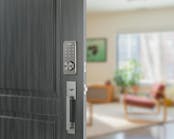10 Years Ago
Locksmith Ledger’s June 2014 cover focus was The Commercial Door. The article “Fire Doors from A to Z” looked at code compliance requirements and fire door labels. Allegion’s Jeremy Earles wrote about the value of hybrid credentials as smart cards became dominant, a few years before the smartphone became the credential of choice. Steve Young concluded his two-part series on servicing the (then brand new) 2014 Chevrolet Impala. Gale Johnson reported on code machines: the A1 Mean Green Machine, Framon #2, Ilco Futura, Pro-Lok Blue Punch and Rapidkey 7000. Another key machine article was titled “Key Features of a Keyline 994.” Key machines have advanced greatly in the past decade, but many of these machines are still in use. Levine covered the basics of controlling access with electromagnetic locks. The article “Power over Ethernet Technology For Access Control” looked at power needs for both electronic locks and video surveillance systems.
20 Years Ago
High security locks were featured in the June 2004 issue. Jerry Levine studied the new Corbin-Russwin Pyramid lock system. Gale Johnson reported on the ML key system by Master Lock. Wade Landrum was a strong advocate for the Scorpion CX-5 High Security lock program. Dale Bowman, Medeco Security Locks, explained how patents affect the long-range security of high security lock cylinders. Tom Gillespie checked the GE Supra pushbutton lock lineup. D&D Technologies showed how to install their Lokk-Latch gate lock. Jet Hardware introduced a new line of cam locks, file cabinet locks, mailbox locks and showcase locks. Tim O'Leary wrote about a new GE-TRACcess access control system. Jerry Levine tackled a vintage Sargent padlock and fit a new operating key. Rod Oden looked at security from the perspective of a corporation. A Bianchi (Keyline) 303 manual sidewinder duplicator was put to the test. Jerry Levine visited the 2004 Los Angeles auto show and reported on what he found. Jerry Levine also had numerous new car tips in his Locksmithing Etc. column. Tiny dissected 2004 Malibu Maxx locks and fit new keys
Commercial Lock Solutions: Three Scenarios
Selling the "right" hardware for a commercial or institutional job is dependent first and foremost upon meeting applicable Life Safety and building codes. If doors open to the public, they are generally considered the path of egress and must accommodate egress without prior knowledge. They also must meet ADA requirements. If the opening is fire rated, additional restrictions apply. After all code requirements are understood, we can then begin to think about and discuss what the owner/end-user wants to do with the door.
Photos show the doors before their upgrades. Read the full article to see what solutions were used.
Scenario 1: Non Fire-Rated Opening: A non-fire rated opening was chosen as our first scenario because it is the least complicated installation. A single pair of double inswinging doors provides access to a storage room that is not available to the public. These doors open to a standard sized storage room that meets local and state building and fire codes. Be aware that local codes, which may vary by location, may determine space size.
Scenario 2: Fire Rated Opening: The pair of outswinging doors in this office building is fire rated. For this installation, new hollow metal, 3-hour fire rated doors were purchased and installed. For this interior application, 18 gauge doors were ordered. The occupancy load, more than 50 persons, requires exit devices as the lock mechanism. Fire doors are required to be self closing and positive latching. The doors were ordered with exit device and door closer reinforcement.
Scenario 3: Grade 1, Non-Fire Rated: The pair of outswinging doors in this office building is not fire rated. The door can be hollow metal or wood. Even though the opening is not fire rated, the door hardware must be Grade 1. For this application, the occupant load is 50 or less, which permits the use of a mortise lock. If the occupancy load was more than 50, the locking mechanism must be exit devices. If the occupancy load is more than 15 and less than 50, both doors must be active, which means each door must have an operable locking mechanism and a fixed position strike plate. If the occupancy load is 15 or less, there can be one active and one inactive door. The inactive door can be equipped with the strike plate.
Read the full article at www.locksmithledger.com/11430760






